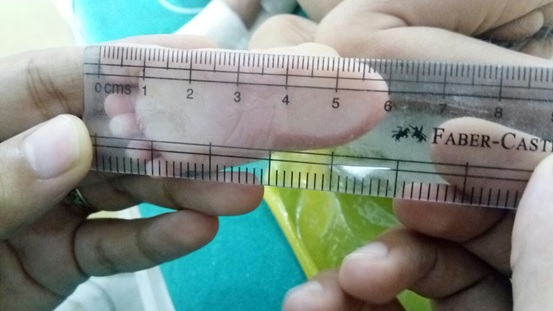Study of foot length measurement as a screening tool to identify low birth weight and preterm neonates
Abstract
Introduction: Low birth weight is an important indicator of survival, future growth, and overall development of the child. It is associated with socio-economic, clinical, racial, hereditary, personal, and geographical factors.
Method: This prospective obser-vational study was conducted during the 19 months in the nursery and postnatal wards at RDGMC, Ujjain. All live birth new-borns were assessed within 24 hours of birth. All Sick babies requiring NICU care, newborns with congenital malformation were excluded from the study. For each newborn recruited in the study length of the left foot was measured from the heel to the tip of the big toe using a hard transparent plastic ruler which was pressed vertically against the babies’ sole and the reading was record-ed. The data was analyzed in Epidata (version 3.1) and then transferred to Stata10.0 (Stata Corp College Station, Texas, U.S.A) for statistical analysis.
Results: (1) Foot length measurement was directly correlated with gestational age with cut off being 6.3 cm for 32 weeks,6.6 cm for 36 weeks, and 7.35 cm for > 36 weeks. (2) Foot length measurement directly correlated with the birth weight with the cut off for VLBW babies being 6.25 cm, for weight< 2000gm being 6.78 cm and LBW being 7.92 cm.
Conclusion: Present study strongly recommends foot length measurement as an easy, fast, accurate, and low-cost tool for predicting prematurity and low birth weight not only in the hospital setup but also for community health providers.
Downloads
References
Park K. Park’s Textbook of Preventive and Social Medicine. 24th ed. Jabalpur: M/S Banarsidas Bhanot;.Page no.605
Paul VK, Sachdev HS, Mavalankar D, et al. Reproductive health, and child health and nutrition in India: meeting the chal-lenge. Lancet. 2011;377(9762):332-349. doi:10.1016/S0140-6736(10)61492-4.
Howson C P, Kinney MV, McDougall L, Lawn, JE. Born Too Soon Preterm Birth Action Group. Born too soon: preterm birth matters. Reproduct Health. 2013;10(1):S1. doi: 10.1186/1742-4755-10-S1-S1.
Bang AT, Bang RA, Baitule S, Deshmukh M, Reddy MH. Burden of morbidities and the unmet need for health care in rural neonates--a prospective observational study in Gadchiroli, India. Indian Pediatr. 2001;38(9):952-965.
Sharma JN, Saxena S, Sharma U. Relationship between birth weight and other neonatal anthropometeric parameters. Indian Pediatr. 1988;25(3):244-248.
P Opara. Gestational Age Assessment In The Newborn – A Review. Internet J Pediatr Neonatol. 2009;12:2.
Ballard JL, Khoury JC, Wedig K, Wang L, Eilers-Walsman BL, Lipp R. New Ballard Score, expanded to include extremely premature infants. J Pediatr. 1991;119(3):417-423. doi: 10.1016/s0022-3476(05)82056-6.
Mukherjee S, Roy P, Mitra S, Samanta M, Chatterjee S. Measuring new-born foot length to identify small babies in need of extra care: a cross-sectional hospital based study. Iran J Pediatr. 2013;23(5):508-512.
Saroj DA, Sharma D, Singh, DM. Measurement of Neonatal Foot Length to Identify Low Birth Weight Babies : a cross-sectional hospital-based study. J Dent Med Sci. 2016;15(6).
Gohil JR, Sosi M, Vani SN, Desai AB. Foot length measurement in the neonate. Indian J Pediatr. 1991;58(5):675-677. doi: 10.1007/BF02820189.
KC A, Nelin V, Vitrakoti R, Aryal S, Målqvist M. Validation of the foot length measure as an alternative tool to identify low birth weight and preterm babies in a low-resource setting like Nepal: a cross-sectional study. BMC Pediatr. 2015;15:43. doi: 10.1186/s12887-015-0361-4.
James DK, Dryburgh EH, Chiswick ML. Foot length--a new and potentially useful measurement in the neonate. Arch Dis Child. 1979;54(3):226-230. doi: 10.1136/adc.54.3.226.
Daga SR, Daga AS, Patole S, Kadam S, Mukadam Y. Foot Length Measurement from Foot Print for Identifying a Newborn at Risk. J Trop Pediatr. 1988;34(1):16-19: doi: 10.1093/tropej/34.1.16.
Mathur A, Tak SK, Kothari P. 'Foot length'--a newer approach in neonatal anthropometry. J Trop Pediatr. 1984;30(6):333-336. doi: 10.1093/tropej/30.6.333.
Anshuman S, SHARMA, Utkarsh S, Sumit K. To study correlation of foot length and gestational age of new born by new Ballard score. Int J Res Med Sci. 2017;3(11): 3119-3122. doi: 10.18203/2320-6012.ijrms20151147.
Amar MT, Rewat M, Amol L. Neonatal Foot Length: An Alternative Predictor of Low Birth Weight Babies in Rural India. Acad J Ped Neonatol. 2016;1(4):555569. doi: 10.19080/AJPN.2016.01.555569.
Mullany LC, Darmstadt GL, Khatry SK, Leclerq SC, Tielsch JM. Relationship between the surrogate anthropometric measures, foot length and chest circumference and birth weight among newborns of Sarlahi, Nepal. Eur J Clin Nutr. 2007;61(1):40-46. doi:10.1038/sj.ejcn.1602504

Copyright (c) 2020 Author (s). Published by Siddharth Health Research and Social Welfare Society

This work is licensed under a Creative Commons Attribution 4.0 International License.


 OAI - Open Archives Initiative
OAI - Open Archives Initiative


